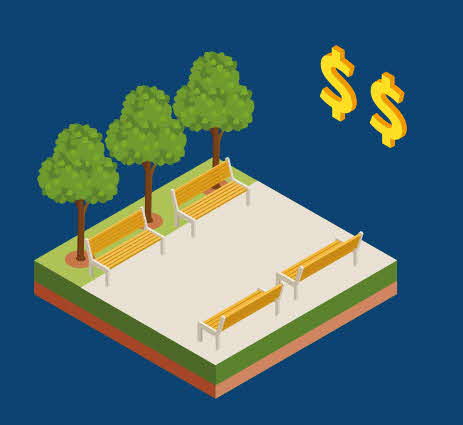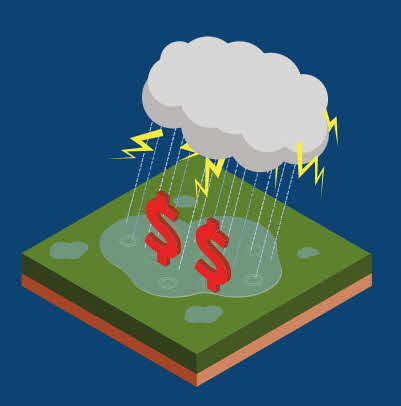Valuing Sustainability and the Environment
ETHOS Issue 24, August 2022

Introduction
Cost-benefit analysis (CBA) is a standard tool that policymakers use to evaluate policies. In a typical CBA, the monetary value of a policy’s costs and benefits are computed and compared. If the benefits of the policy outweigh its costs, it means that implementing it would increase society’s welfare, on balance. For instance, when evaluating whether to build a park, policymakers would weigh the fiscal costs of financing its construction vis-à-vis the monetary and non-monetary benefits for park users and residents in the vicinity.
However, applying CBA to sustainability and environmental policymaking is challenging. Unlike other economic goods and services, property rights for environmental goods are typically poorly defined as no stakeholder owns the environment and there are no markets to trade environmental goods. Consequently, the corresponding monetary value of the benefits of environmental protection generally cannot be inferred from market valuation. Undervaluing these externalities can therefore lead to the under-provision of environmental public goods.
Given the above limitations of market valuation of environmental goods, a range of non-market valuation techniques have been developed to estimate the benefits of protecting the environment, which in turn may better inform policymaking in the environmental domain. These techniques can be broadly categorised as revealed preference and stated preference methods.
Unlike other economic goods and services, property rights for environmental goods are typically poorly defined as no stakeholder owns the environment and there are no markets to trade environmental goods.
Revealed Preference Approach
In a revealed preference approach, non-marketed values are estimated by observing data on behaviours in a proxy market (such as a non-marketed attribute that has an impact on property prices). A common strategy in revealed preference studies is hedonic pricing, which estimates the value of a good and breaks its value down into constituent characteristics. For instance, this method hypothesises that potential home buyers would be willing to pay more for houses with better environmental quality, and that home sellers value better environmental quality, so sellers would only agree to sell a house which is located in an area with a better environment if it commands a higher price. As such, when applied to home prices and with appropriate data on environmental characteristics, hedonic pricing on property transactions can provide insight into the value of protecting the environment.
Another approach in revealed preference studies is the travel cost method, which estimates the value of the environment by observing whether an individual is willing to invest time and effort to travel to a place with a good natural environment. This method hypothesises that if an individual decides to visit such a location, his valuation of the visit would be equivalent to or higher than the costs of travelling to it. Such costs could include both direct costs of travelling and indirect or implicit costs of time foregone due to the visit. However, in small, highly urbanised cities like Singapore, the travel cost method may undervalue the non-market value of Singapore’s environmentally attractive sites, due to the ease of mobility within a small geographical region.
Researchers found that vegetation accounted for around 3% of the average property value, for all public housing apartments sold between April 2013 and April 2014.
Revealed Preference in Practice
A range of environmental goods have been valued in revealed preference studies, such as:
|
|
|
|
|
Improved air quality1, 2, 3, 4, 5 |
The impact of water quality on house prices6, 7, 8 |
The impact of hazard waste clean-up on the housing market9, 10 |
NOTES
- D. Jr. Harrison and D. L. Rubinfeld, “Hedonic Housing Prices and the Demand for Clean Air”, Journal of Environmental Economics and Management 5, no. 1 (1978): 81–102.
- V. Kerry Smith and Ju-Chin Huang, "Can Markets Value Air Quality? A Meta-Analysis of Hedonic Property Value Models", Journal of Political Economy 103, no. 1 (1995): 209–227.
- K. Y. Chay and M. Greenstone, “Does Air Quality Matter? Evidence from the Housing Market”, Journal of Political Economy 113, no. 2 (2005): 376–424.
- C. W. Kim, T. T. Phipps, and L. Anselin, “Measuring the Benefits of Air Quality Improvement: A Spatial Hedonic Approach”, Journal of Environmental Economics and Management 45, no. 1 (2003): 24–39.
- P. Bayer, N. Keohane, and C. Timmins, “Migration and Hedonic Valuation: The Case of Air Quality”, Journal of Environmental Economics and Management, 58, no. 1 (2009): 1–14.
- C. G. Leggett, and N. E. Bockstael, “Evidence of the Effects of Water Quality on Residential Land Prices”, Journal of Environmental Economics and Management 39, no. 2 (2000): 121–144.
- P. J. Poor, K. L. Pessagno, and R. W. Paul, “Exploring the Hedonic Value of Ambient Water Quality: A Local Watershed-Based Study”, Ecological Economics 60, no. 4 (2007): 797–806.
- P. J. Walsh, J. W. Milon, and D. O. Scrogin, “The Spatial Extent of Water Quality Benefits in Urban Housing Markets”, Land Economics 87, no. 4 (2011): 628–644.
- M. Greenstone and J. Gallagher, “Does Hazardous Waste Matter? Evidence from the Housing Market and the Superfund Program”, The Quarterly Journal of Economics 123, no. 3 (2008): 951–1003.
- S. Gamper-Rabindran and C. Timmins, “Does Cleanup of Hazardous Waste Sites Raise Housing Values? Evidence of Spatially Localized Benefits”, Journal of Environmental Economics and Management 65, no. 3 (2013): 345–360.
In Singapore’s context, academics have used the hedonic pricing approach to estimate the value of vegetation and greenery. In one study, Belcher and Chisholm examined the impact of different types of green spaces on the resale prices of public housing apartments built by the Housing and Development Board (HDB).1
The study found that managed vegetation (e.g., parks, park connector network and roadside greenery) was associated with higher property values. These results were in line with the intuition that residents were willing to pay more for the ecosystem services and recreational activities provided by this greenery. The researchers also found that this vegetation accounted for around 3% of the average property value, amounting to a total monetary value of S$179 million for all public housing apartments sold between April 2013 and April 2014.
These results corroborated the findings of a 2016 MSE study which estimated the non-market value of the Active, Beautiful and Clean Waters (ABC Waters) project at the Bishan-Ang Mo Kio (AMK) Park.2 The study employed a difference-in-differences methodology to estimate the causal impact of the ABC Waters project on the prices of nearby properties. After taking into account macroeconomic trends and factors that could affect property prices, differences in house values between houses nearer to and further away from the Bishan-AMK Park could be attributed to the Bishan-AMK Park. Results from the analysis suggest that residents were willing to pay for the improvement in park amenities associated with the ABC Waters project.
While revealed preference studies have been applied to a wide range of environmental goods, there can be limitations to this non-market valuation approach. First, a suitable proxy market needs to be identified and such a market might not exist in some cases. For example, hedonic pricing can only be used to estimate the value of green spaces to residents staying near parks. Individuals staying far away from these parks might place value on green spaces, but do not reveal their preferences through housing prices. Second, revealed preferences might not be able to account for all the factors that affect house prices, especially when aspects of individual preferences are unobserved.
To overcome these limitations, researchers use the stated preference approach to non-market valuation.
Stated Preference Approach
Unlike the revealed preference approach, stated preference studies elicit individuals’ valuation of an environmental good through surveys. These studies can estimate the willingness-to-pay for environmental goods even in the absence of a proxy market, since they ask respondents for their valuations directly.
Stated preference approaches can be broadly categorised into contingent valuation and choice modelling studies. In a contingent valuation study, respondents to the survey are presented with a hypothetical change in the environment (e.g., building a new park in the neighbourhood) and asked if they would be willing to pay for that change. A choice modelling study extends the contingent valuation methodology by presenting respondents with a series of choice situations. These choice situations are designed with a fixed set of attributes, but each alternative in the choice situation will contain combinations of different levels of the attributes. For example, attributes could include the number of trees, park size, park amenities, and costs to the respondent. Respondents are then asked to choose their preferred alternative in each choice situation. Analysis of respondent choices provides an estimate of the willingness-to-pay for the attributes used to describe the policy options.
The survey questionnaires used in stated preferences studies need to be carefully designed to ensure that accurate estimates of willingness-to-pay are obtained. To guide the development of such questionnaires in stated preferences studies, the US National Oceanic and Atmospheric Administration (NOAA) convened a panel of economists led by two Nobel laureates to evaluate the stated preference approach.4 The NOAA panel concluded that stated preference surveys should follow a set of best practices to obtain reliable willingness-to-pay estimates. These include: (i) defining the status quo and the changes to this status quo; (ii) choosing the elicitation method (how the respondents’ willingness-to-pay are obtained, e.g., open-ended or dichotomous choice question) and the payment vehicle (the modes of payment for the good or policy e.g., fees or increased taxes); (iii) implementing the survey on the target sample population; and (iv) estimating the willingness-to-pay based on responses to the survey. These best practices have been updated over the years through research and experience.5
The survey questionnaires used in stated preferences studies need to be carefully designed to ensure that accurate estimates of willingness-to-pay are obtained.
Stated Preference in Practice
Stated preference studies have been used in a wide range of contexts to estimate the value of environmental goods, including:
|
|
|
|
|
Damage assessments from pollution events, such as the Exxon-Valdez oil spill in the US1 |
The value of the natural environment2, 3, 4 |
The willingness-to-pay for climate change and adverse weather events5, 6 |
NOTES
- R. T. Carson, R. C. Mitchell, M. Hanemann, R. J. Kopp, S. Presser, and P. A. Ruud, “Contingent Valuation and Lost Passive Use: Damages from the Exxon Valdez Oil Spill”, Environmental and Resource Economics 25, no. 3 (2003): 257–286.
- J. Bennett, “The Contingent Valuation Method: A Post-Kakadu Assessment”, Agenda: A Journal of Policy Analysis and Reform (1996): 185–194.
- J. N. Sanchirico, D. K. Lew, A. C. Haynie, D. M. Kling, and D. F. Layton, “Conservation Values in Marine Ecosystem-Based Management”, Marine Policy 38 (2013): 523–530.
- R. Scarpa, T. J. Gilbride, D. Campbell, and D. A. Hensher, “Modelling Attribute Non-Attendance in Choice Experiments for Rural Landscape Valuation”, European Review of Agricultural Economics 36, no. 2 (2009): 151–174.
- S. Akter, J. Bennett, and M. B. Ward, “Climate Change Scepticism and Public Support for Mitigation: Evidence from an Australian Choice Experiment”, Global Environmental Change 22, no. 3 (2012): 736–745.
- W. D. Shaw and J. Baker, “Models of Location Choice and Willingness to Pay to Avoid Hurricane Risks for Hurricane Katrina Evacuees, International Journal of Mass Emergencies and Disasters 28, no. 1 (2010): 87–114.
Technology has enabled researchers to better describe proposed changes to the status quo, enabling respondents to visualise the impact of different proposed options. Iftekhar et al. designed a novel choice modelling survey that used virtual reality to describe proposed ABC Waters projects to respondents.6 This enabled respondents to immerse themselves in the envisioned ABC Waters environment when making their choice.
Leong also used a novel survey questionnaire design to estimate the willingness-to-pay for construction noise abatement by using audio clips to enable respondents to perceive different noise levels.7 This approach circumvented the limitations of previous studies that used textual descriptions of noise levels, which may be difficult for respondents to appreciate.
Ng, Foo, and Leong also used a choice modelling survey to estimate the willingness-to-pay for various typologies of active mobility (AM) infrastructure.8 A key variable in the choice modelling survey was the maximum permissible speed of active mobility devices. The researchers provided respondents with relevant images and videos corresponding to the attribute levels in each choice set to clarify understanding of the choice task.
Conclusion
Market failures associated with environmental protection and sustainability presents a unique set of challenges for policymakers. Unlike most other economic goods, markets for environmental goods are typically non-existent and it is not possible to infer the value of the environment from market values. Hence, we look at the use of non-market valuation techniques to estimate the monetary benefits of environmental goods.
The techniques described above can be applied to a wide range of environmental policies, including promoting resource conservation, encouraging circular economy, mitigating climate change, and maintaining public cleanliness and hygiene. Estimates from these studies provide a more accurate assessment of benefits associated with policies, thus enabling policymakers to more fully weigh the costs and benefits of environmental protection policies.
Technology has enabled researchers to better describe proposed changes to the status quo.
However, there are some limitations to non-market valuation techniques. For instance, the revealed preference approach can only be used when there is a suitable proxy market to reference and data is available for collection and analysis. In the case of stated preference surveys, there is a long process of first crafting the right survey questionnaire, then conducting the survey and eventually collecting respondents’ data for analysis. There is also a need to balance the trade-off between the sample size of survey respondents for more robust analysis and the overall costs to conduct the study. Hence, for stated preference studies, sufficient time must be set aside for the study, and they should only be undertaken if the fiscal outlay and/or environmental impact of the policy being considered is significant.
NOTES
- R. N. Belcher and R. A. Chisholm, “Tropical Vegetation and Residential Property Value: A Hedonic Pricing Analysis in Singapore”, Ecological Economics 149 (2018): 149–159. The researchers used ordinary least squares regression in the baseline model and controlled for location characteristics (e.g., distance to nearby schools, food centres and transportation nodes) and apartment attributes (e.g., floor area, apartment type, and storey). A key assumption of the ordinary least squares regression is that the residuals of the regression are independently and identically distributed. As property prices of nearby apartments may be more highly correlated than properties that are located further away, the researchers controlled for this spatial autocorrelation by estimating a hierarchical mixed-effect model.
- Leong Chi Hoong, “Cost Benefit Analysis of the Active, Beautiful and Clean Waters Programme”, quoted in Evidence-based Policymaking in Singapore: A Policymaker’s Toolkit
- The study categorised properties into treatment and control groups based on their distance from the park. The treatment group was defined to be properties within 400 m of the park, while properties located 400 m to 600 m away from the park were placed in the control group. Both groups were exposed to similar macroeconomic trends, but the treatment group enjoyed better amenities from the ABC Waters project. As such, comparison of the price trends of the control and treatment groups allowed the impact of the Bishan-AMK Park’s ABC Waters project on house value to be isolated.
- K. Arrow, R. Solow, P. R. Portney, E. E. Leamer, R. Radner and H. Schuman, “Report of the NOAA Panel on Contingent Valuation”, Federal Register 58, no. 10 (1993): 4601–4614.
- For a review of these practices, see: R. J. Johnston, K. J. Boyle, W. Adamowicz, J. Bennett, R. Brouwer, T. A. Cameron et al., “Contemporary Guidance for Stated Preference Studies”, Journal of the Association of Environmental and Resource Economists 4, no. 2 (2017): 319–405.
- M. S. Iftekhar, J. Buurman, T. K. Lee, Q. He, and E. Chen, “Non-Market Value of Singapore's ABC Waters Program”, Water Research 157 (2019): 310–320.
- C. H. Leong, Willingness to Pay for Noise Abatement in Singapore (Canberra: Australian National University, 2019).
- W. Ng and T. Foo, “Estimating Singaporeans' Willingness-to-Pay for Active Mode Infrastructure” (internal study, Land Transport Authority, 2020).







